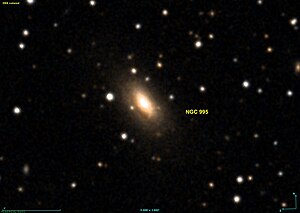NGC 995
| Galaxy NGC 995 |
|
|---|---|

|
|
| AladinLite | |
| Constellation | Andromeda |
|
Position equinox : J2000.0 , epoch : J2000.0 |
|
| Right ascension | 02 h 38 m 32.0 s |
| declination | + 41 ° 31 ′ 45 ″ |
| Appearance | |
| Morphological type | S0 |
| Brightness (visual) | 13.5 likes |
| Brightness (B-band) | 14.5 mag |
| Angular expansion | 1.3 ′ × 0.6 ′ |
| Position angle | 35 ° |
| Surface brightness | 13.1 mag / arcmin² |
| Physical data | |
| Redshift | 0.013326 ± 0.000067 |
| Radial velocity | 3995 ± 20 km / s |
|
Stroke distance v rad / H 0 |
(184 ± 13) x 10 6 ly (56.4 ± 4.0) Mpc |
| history | |
| discovery | Édouard Stephan |
| Discovery date | December 8, 1871 |
| Catalog names | |
| NGC 995 • UGC 2118 • PGC 10008 • CGCG 539-063 • MCG + 07-06-044 • 2MASX J02383202 + 4131452 • GALEX ASC J023831.86 + 413144.8 • LDCE 224 NED047 | |
NGC 995 is a lenticular galaxy of the Hubble type S0 in the constellation Andromeda in the northern sky . It is estimated to be 184 million light years away from the Milky Way and has a diameter of around 40,000 ly.
In the same area of the sky are the galaxies NGC 996 , NGC 999 , NGC 1000 , NGC 1001 , among others .
The object was discovered on December 8, 1871 by the French astronomer Édouard Stephan .
